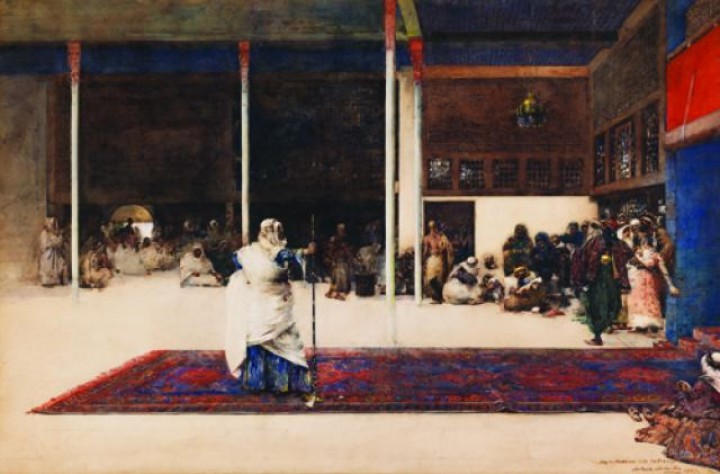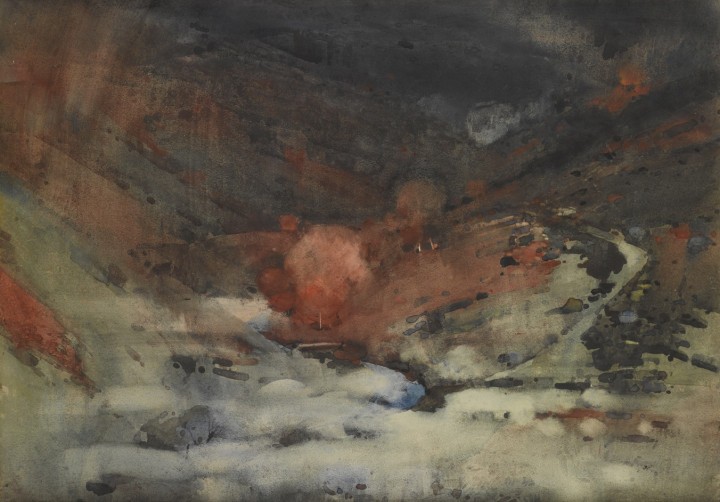Scottish Art News
Latest news
Magazine
News & Press
Publications
My Favourite Scottish Work of Art: Sir Tim Rice
By Tim Rice, 13.08.2020

The lyricist and author Sir Tim Rice has chosen a favourite from his family’s own collection, by the Scottish painter - and Fleming Collection favourite - Arthur Melville. The chosen watercolour, Awaiting an Audience with the Pasha, was painted in 1887.
“This has always been one of the Rice family’s favourite paintings. When the picture was included in the Glasgow Boys exhibition at the Royal Academy in 2011, Brian Sewell devoted about half his review to this picture alone, saying he would 'enter into a Faustian bargain to possess it'. We did not need to enter into such a difficult negotiation. For me, I love Melville because he is simultaneously exact and free with his colours and images, as if effortlessly combining information and imagination.”
 Sir Tim Rice.
Sir Tim Rice.
Sir Timothy Rice (born in 1944), who owns the Dundonnell Estate in the Scottish Highlands, is an English lyricist who has co-authored some of the most successful stage and film musicals of the 20th century. After some years in music production, Rice turned his hand to writing lyrics with spectacular success. The recipient of three Oscars, Rice is renowned for his collaborations with composer Andrew Lloyd Webber, with whom he wrote, among others, Joseph and the Amazing Technicolor Dreamcoat and Evita. He also worked with Disney on the music for Aladdin, The Lion King and the stage adaptation of Beauty and the Beast. Rice was knighted by the Queen for services to music in 1994. He has a star on the Hollywood Walk of Fame, is a fellow of the British Academy of Songwriters, Composers, and Authors and is one of only sixteen artists to have won an Emmy, Oscar, Grammy and Tony.
Brian Sewell (1931 – 2015) was one of the most inciteful and merciless art critics of his generation. Trained at the Courtauld Institute, he pursued a career in the Old Master department at Christies before becoming an art critic for the London Standard. Fearless in excoriating the mediocre, especially in the work of acclaimed contemporary artists, he became one of the most influential art critics in the UK. His connoisseurship led him to build up an art collection on little money which was sold on his death by Christies. The Fleming Collection later acquired William Orchadson’s Ophelia which was in his collection.
 Arthur Melville, The Highland Glen, c. 1893. The Fleming Collection.
Arthur Melville, The Highland Glen, c. 1893. The Fleming Collection.
Arthur Melville (1855 – 1904) was brought up in East Lothian, the son of a coachman. A precocious talent, he attended art school in Edinburgh, soon having paintings accepted by the Royal Scottish Academy. He was the first of his generation to paint (in 1877) an iconic image of a labourer in a kailyard, which was hung at the Royal Academy, London. Always quick off the mark, he was one of the first young Scots, while studying in Paris, to discover the artists’ colony, Grez-sur-Loing where he painted limpid scenes of everyday life. As such, Melville was a transmitter of French cutting-edge realism to his Scottish contemporaries. Melville joined the Glasgow Boys at the artists’ colony of Cockburnspath, fresh from an adventurous expedition to the Middle East, which resulted in a series of finished watercolours, including Awaiting an Audience with the Pasha. When exhibited in London The Magazine of Art described its treatment of figures and ‘gorgeous oriental carpets’ as ‘beyond praise’.
Melville’s travels to the Middle East revealed his brilliance as a watercolourist and he soon abandoned oil painting. His fluid technique, sometimes described as ‘blottesque’, and daring artistic intelligence took his landscapes to the edge of abstraction, as the proto-modern The Highland Glen reveals. Melville’s fearless innovation sums up the bold character and achievements of the Glasgow Boys and Girls who learnt to look at life with an unflinching gaze that betokened the dawn of the modern world.
Explore other works by Arthur Melville in the collection here.
Other artworks in the series 'My Favourite Scottish Work of Art' have been selected by Alison Watt, Ian Rankin, Joanna Lumley, Neil MacGregor, Kirsty Wark, Michael Portillo and James Naughtie.




